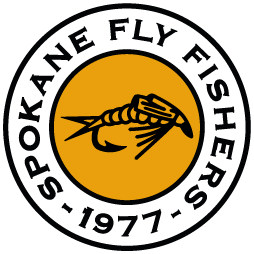by Ken Burkholder, Boise, ID.
Fish this big Royal Coachman variant during grasshopper season or when the big stoneflies are popping. Ken Burkholder recommends fishing this pattern and his Undertaker TM with a loop knot to increase their movement on the surface of the water.
“This fly was a new creation for 2002,” says Burkholder. “It is similar to a Royal Coachman or a Red Ant. The difference is the moose-hair tail, the rubber legs, and the grizzly bear hair wing. Brown trout have a preference for this fly. I don’t know how many three- to five-pound trout I’ve fooled with this pattern. Fish it during the salmonfly hatch and check it out.”
Ken applies the Ice Dubbing in a dubbing loop, and coats the silk-thread abdomen with epoxy. Both of these practices make this pattern much more durable than a standard Royal Wulff.
Hook: Daiichi Style 1270 Curved Hook Size 6
Thread: Red 6/0 or Veevus 100 D Red
Tail: Moose hair
Butt: Peacock Ice Dubbing
Abdomen: Tying Thread
Wing: Grizzly Bear underfur, Widow’s Web Golden Stone, or similar
Thorax: Peacock Ice Dubbing
Hackle: Furnace sized for size 6 hook
Legs: Small rubber legs
This fly is a Royal Coachman variant for grasshopper season or big stoneflies.
- Place hook in vise. Start thread 1/8” back from the eye of the hook. Run the thread back to a point above the barb of the hook.
- Select a 1/4” in diameter or a bit smaller chunk of moose hair. Stack the hair and tie it to hook with a length about a third of the hook shank long hanging off. Drop some super glue over the thread to keep it from rotating. The hair should stick up in the rear at a slight angle and parallel to the hook point.
- Build a dubbing loop about 3 inches long. Tie it off and place dubbing tool in bottom of loop. Place a small amount of the dubbing in the loop, spin your dubbing tool to form a dubbing brush approximately 5/16” in diameter. Next wind it around the hook shank about 1/4” in length to form a collar around the hook. Tie it off and cut off the excess dubbing brush.
- At the same point, tie off a 2” length of leg on each side of the hook so the each end extends away from the hook at 45 degrees.
- Run several layers of thread up to a point 1/2 way between the starting point and the back of the hook eye. Cover the shank with several layers. To improve the durability of the fly cover it with UV light curing resin coating or clear nail polish.
- Cut a section of Widow’s Web, Grizzly Bear under fur or similar about as long as the hook shank. Try to select a chunk of under fur so it is bigger at the rear end than at the front.
With Widow’s Web the wing will be the same dimension its whole length. When it is placed correctly it will extend out to the same point as the moose hair tail. With several wraps of thread fasten the hair to the hook. - Select a hackle feather with barbs sized for a size 6 hook or 1 1/2 times the width of the hook gap. Clean the stem of non-useable feathers. At the point where the Widow’s Web or whatever you chose tie off a section of Furnace hackle for a size 6 hook by the cleaned off feather stem.
- Just past this point tie off a rubber leg on each side of the hook with the ends at a 45 degree angle to the hook shank.
- At the same point tie off a dubbing loop and repeat the process as in #3. Secure the thread just behind the hooks eye temporarily.
- Wind the hackle through the dubbing and tie it off on the hook shank. You will want the concave portion of the feather facing forward. When this hackle is wound around the hook shank there should be about 3/8” to 1/2” of length.
- Complete the fly with a whip finish and glue if you chose.
- Trim the legs as you desire. Some folks like to leave the two front “legs or antennas” longer than the other legs on the fly.
